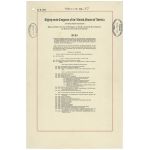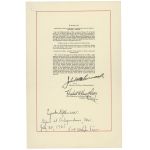Medicare and Medicaid Act
7/30/1965
Add to Favorites:
Add all page(s) of this document to activity:

Add only page 1 to activity:
Add only page 2 to activity:
This act – officially titled Social Security Amendments of 1965 – was signed into law by President Lyndon Johnson on July 30, 1965. It established Medicare, a health insurance program for the elderly, and Medicaid, a health insurance program for people with limited income.
Medicare is one basic program of health insurance for persons aged 65 and older. Medicaid provides health insurance for people with limited income funded by state and federal sources respectively. It was funded by a tax on the earnings of employees, matched by contributions by employers, and was well received. In the first three years of the program, nearly 20 million beneficiaries enrolled in it.
Debate over the program actually began two decades earlier when President Harry S. Truman sent a message to Congress asking for legislation establishing a national health insurance plan. At that time, vocal opponents warned of the dangers of "socialized medicine." By the end of Truman’s administration, he had backed off from a plan of universal coverage; but administrators in the Social Security system and others began to focus on the idea of a program aimed at insuring Social Security beneficiaries whose numbers and needs were growing.
The 1950 census showed that the elderly population in the United States had grown from 3 million in 1900 to 12 million in 1950. Two-thirds of older Americans had incomes of less than $1,000 annually; and only one in eight had health insurance. Between 1950 and 1963, the elderly population grew from about 12 million to 17.5 million, or from 8.1 to 9.4 percent of the total U.S. population. At the same time, the cost of hospital care was rising at a rate of about 6.7 percent a year – several times the annual increase in the cost of living – and health care costs were rapidly outpacing growth in the incomes of older Americans.
Private insurers had long considered this illness-prone population a "bad risk." A broad debate about the need for a social insurance program to provide older Americans with reliable health care coverage started within the Social Security Administration and in Congress. Public hearings were held, and the House of Representatives considered several proposals, but the debate did not intensify until 1960, when it became clear that private insurers were becoming increasingly incapable of providing comprehensive, affordable health care coverage to the rapidly growing population of older adults. Between 1960 and 1965, the health coverage debate was a front-burner issue in Congress, with dozens of proposals introduced and testimonies given by representatives of major organizations, including the American Hospital Association, the American Medical Association, and the AFL-CIO.
After Congress passed the legislation in the summer of 1965, President Lyndon Johnson decided to sign the bill with former President Truman at the Truman Presidential Library in Independence, Missouri, in order to recognize Truman’s early effort to establish a national health insurance program. On July 30, 1965, Air Force One departed for Missouri with the President; Mrs. Johnson; George Meany, president of the AFL-CIO; Secretary of Health, Education and Welfare Anthony Celebrezze; Governor John Connally of Texas; 13 U.S. Senators; and 19 U.S. Representatives. President Johnson and his party were met by President and Mrs. Truman at the Truman Library in Independence. They visited for some time before moving on to the platform in the auditorium of the library for the bill signing. After some brief remarks, President Johnson signed the Medicare and Medicaid Act into law. Johnson gave the first souvenir pen to Mrs. Truman and the next to President Truman and then the remainder of the pens to guests on the platform.
Medicare is one basic program of health insurance for persons aged 65 and older. Medicaid provides health insurance for people with limited income funded by state and federal sources respectively. It was funded by a tax on the earnings of employees, matched by contributions by employers, and was well received. In the first three years of the program, nearly 20 million beneficiaries enrolled in it.
Debate over the program actually began two decades earlier when President Harry S. Truman sent a message to Congress asking for legislation establishing a national health insurance plan. At that time, vocal opponents warned of the dangers of "socialized medicine." By the end of Truman’s administration, he had backed off from a plan of universal coverage; but administrators in the Social Security system and others began to focus on the idea of a program aimed at insuring Social Security beneficiaries whose numbers and needs were growing.
The 1950 census showed that the elderly population in the United States had grown from 3 million in 1900 to 12 million in 1950. Two-thirds of older Americans had incomes of less than $1,000 annually; and only one in eight had health insurance. Between 1950 and 1963, the elderly population grew from about 12 million to 17.5 million, or from 8.1 to 9.4 percent of the total U.S. population. At the same time, the cost of hospital care was rising at a rate of about 6.7 percent a year – several times the annual increase in the cost of living – and health care costs were rapidly outpacing growth in the incomes of older Americans.
Private insurers had long considered this illness-prone population a "bad risk." A broad debate about the need for a social insurance program to provide older Americans with reliable health care coverage started within the Social Security Administration and in Congress. Public hearings were held, and the House of Representatives considered several proposals, but the debate did not intensify until 1960, when it became clear that private insurers were becoming increasingly incapable of providing comprehensive, affordable health care coverage to the rapidly growing population of older adults. Between 1960 and 1965, the health coverage debate was a front-burner issue in Congress, with dozens of proposals introduced and testimonies given by representatives of major organizations, including the American Hospital Association, the American Medical Association, and the AFL-CIO.
After Congress passed the legislation in the summer of 1965, President Lyndon Johnson decided to sign the bill with former President Truman at the Truman Presidential Library in Independence, Missouri, in order to recognize Truman’s early effort to establish a national health insurance program. On July 30, 1965, Air Force One departed for Missouri with the President; Mrs. Johnson; George Meany, president of the AFL-CIO; Secretary of Health, Education and Welfare Anthony Celebrezze; Governor John Connally of Texas; 13 U.S. Senators; and 19 U.S. Representatives. President Johnson and his party were met by President and Mrs. Truman at the Truman Library in Independence. They visited for some time before moving on to the platform in the auditorium of the library for the bill signing. After some brief remarks, President Johnson signed the Medicare and Medicaid Act into law. Johnson gave the first souvenir pen to Mrs. Truman and the next to President Truman and then the remainder of the pens to guests on the platform.
Transcript
AN ACTTo provide a hospital insurance program for the aged under the Social Security Act with a supplementary medical benefits program and an extended program of medical assistance, to increase benefits under the Old-Age, Survivors, and Disability Insurance System, to improve the Federal-State public assistance programs, and for other purposes.
Be it enacted by the Senate and House of Representatives of the United States of America in Congress assembled, That this Act, with the following table of contents, may be cited as the "Social Security Amendments of 1965".
TABLE OF CONTENTS
TITLE I—HEALTH INSURANCE FOB THE AGED AND MEDICAL ASSISTANCE
SEC. 100. Short title.
PART I—HEALTH INSURANCE BENEFITS FOR THE AGED
SEC. 101. Entitlement to hospital Insurance benefits.
SEC. 102. Hospital insurance benefits and supplementary medical Insurance benefits.
TITLE XVIII—HEALTH INSURANCE FOR THE AGED
SEC. 1801. Prohibition against any Federal interference.
SEC. 1802. Free choice by patient guaranteed.
SEC. 1808. Option to Individuals to obtain other health insurance protection.
PART A—HOSPITAL INSURANCE BENEFITS FOR THE AGED
SEC. 1811. Description of program.
SEC. 1812. Scope of benefits.
SEC. 1818. Deductibles and coinsurance.
SEC. 1814. Conditions of and limitations on payment for services.
(a) Requirement of requests and certifications.
(b) Reasonable cost of services.
(c) No payments to Federal providers of services.
(d) Payments for emergency hospital services.
(e) Payment for Inpatient hospital services prior to notification of noneligibility.
(f) Payment for certain emergency hospital services furnished outside the United States.
SEC. 1815. Payment to providers of services
SEC. 1816. Use of public agencies or private organizations to facilitate payment to providers of services.
SEC. 1817. Federal hospital insurance trust fund.
PARTT B—SUPPLEMENTARY MEDICAL INSURANCE BENEFITS FOR THE AGED
SEC. 1831. Establishment of supplementary medical insurance program for the aged.
SEC. 1832. Scope of benefits.
SEC. 1838. Payment of benefits.
SEC. 1834. Limitation on home health services.
SEC. 1885. Procedure for payment of claims of providers of services.
SEC. 1886. Eligible individuals.
SEC. 1887. Enrollment periods.
SEC. 1888. Coverage period.
SEC. 1889. Amounts of premiums.
SEC. 1840. Payment of premiums.
SEC. 1841. Federal supplementary medical insurance trust fund.
SEC. 1842. Use of carriers for administration of benefits.
SEC. 1848. State agreements for coverage of eligible individuals who are receiving money payments under public assistance programs.
SEC. 1844. Appropriations to cover Government contributions and contingency reserve.
[pages omitted]
SEC. 410. Effective July 1, 1965, so much of clause (7) of section 402(a) of the Social Security Act as follows the first semicolon is amended by inserting after "except that, in making such determination," the following: (A) the State agency may disregard not more than $50 per month of earned income of each dependent child under the age of 18 but not in excess of $150 per month of earned income of such dependent children in the same home, (B)".
FEDERAL SHARE OF PUBLIC ASSISTANCE EXPENDITURES
SEC. 411. Title XI of the Social Security Act is amended by adding at the end therof (after section 1117, added by section 405 of this Act), the following new section:
"ALTERNATIVE FEDERAL PAYMENT WITH RESPECT TO PUBLIC ASSITANCE EXPENDITURES
"SEC. 1118. In the case of any State which has in effect a plan approved under title XIX for any calendar qyuarter, the total of the payments to which such State is entitled for such quarter, and for each succeeding quarter in the same fiscal year (which for purposes of this section means the 4 calendar quarters ending with June 30), under paragraphs (1) and (2) of sections 3(a), 403(a), 1003(a), 1403(a), and 1603(a) shall, at the option of the State, be determined by application of the Federal medical assistance percentage (as defined in section 1905), instead of the percentages provided under each such section, the the expenditures under its State plans approved under titles I, IV, X, XIV, and XVI, which would be included in determining the amounts of the Federal payments to which such state is entitled under such sections, but without regard to any maximum on the dollar amounts per recipient which may be counted under such sections."
[endorsements]
This primary source comes from the General Records of the United States Government.
National Archives Identifier: 299908
Full Citation: Act of July 30, 1965 (Social Security Amendments of 1965 - 'Medicare'), Public Law 89-97, 79 STAT 286; 7/30/1965; Enrolled Acts and Resolutions of Congress, 1789 - 2011; General Records of the United States Government, Record Group 11; National Archives Building, Washington, DC. [Online Version, https://www.docsteach.org/documents/document/social-security-amendments, April 19, 2024]Rights: Public Domain, Free of Known Copyright Restrictions. Learn more on our privacy and legal page.





